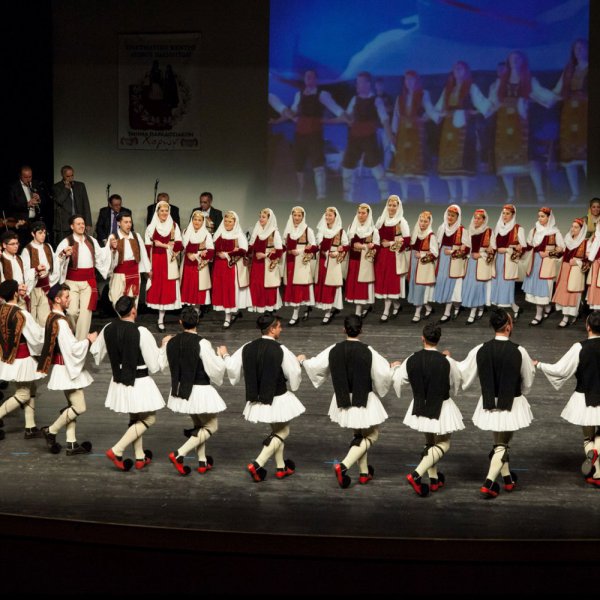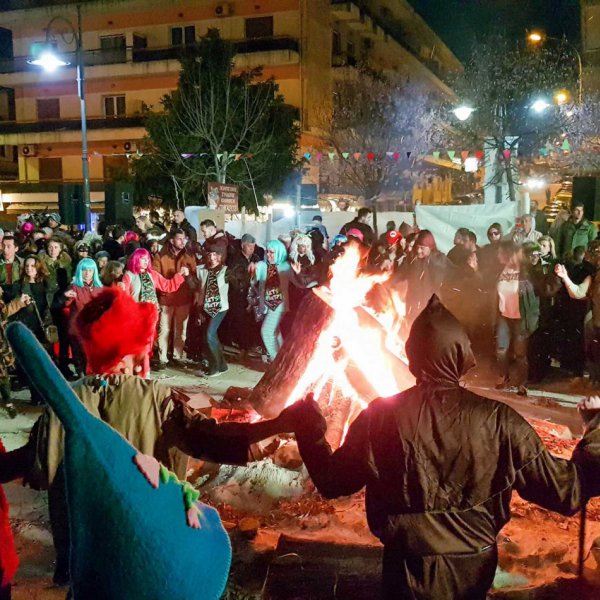Folk tradition - festivals & celebrations
Ioannina and the areas close to the city areas is a place where the entertainment on the occasion of folk festivals and events, in the context of tradition, find an excellent application, while at the same time they are an interesting proposal. A special feature of the music and dance tradition of Ioannina is the way it was shaped in the last centuries, but also evolved to the present day.

Folk Tradition
It is essentially a "mosaic" of rhythms and steps that shaped the urban tradition of Ioannina as a separate unit, but at the same time, separate units and individual music and dance idioms of Epirus are found as separate units due to the inhabitants of the interior of Epirus who settled permanently in the urban center.
The urban tradition of Ioannina is generally composed of the cultural elements of the inhabitants from various regions of Epirus and Greece, but also outside of it, who reside permanently or for long periods in the multicultural, serrenial, eternal city.
They transmit their own on every occasion but are affected alongside interesting elements of others, which in a long process are filtered and created something, you would say, a little different as it has incorporated the influences.
A general outline of the main actors of this coexistence and influences are: Residents from regions of Epirus who come for a short time or longer to Ioannina and often feast or celebrate with their own musicians each (especially in the inns etc. because festivals were not held in the city in the form that we know today in the villages), Ioannina merchants of long journeys who together with goods "transport" to and from Ioannina and cultural elements such as music, educated musicians from other countries who come to the rich urban center (e.g. from Constantinople with classical Ottoman music or Central Europe with traditional music for their dances such as dances, syrba, doina or "European" such as waltz etc.), Also, gypsies who at first play for Muslims and Arvanites and later for Christians, while the influence of Asia Minor musicians is typical After the destruction and exchange of populations giving a different view to shaping urban MO of physics and by extension, of dance.
Decisive was the partial at the beginning and later generalized use of the clarinet mainly but also of the violin with the creation of the "Kumpania" music, the appearance of the gramophone which taught new elements to the musicians and also the arrival of rebetes in the famous “coffee-aman” who conveyed their elements in traditional urban music.
To these, the Jewish community is added with its own songs and music.
All of the above shape and develop the Ioannina music and dance, as they generally reach today, in a depth of at least 200-250 years, culminating in the years of development and especially in the era of Ali Pasha, late 18th century 19th century, until the beginning of the 20th century when creation is essentially stopped.
Perhaps the most characteristic element of Gianni music was the Giannian lyric. It was an improvised composition of the slopes (something similar to the mantinades) and appeared in the 17th century but more in the late 18th century and especially in the 19th century. We encountered it mainly during Halloween in the custom of "Tzamala", the bonfires in the neighborhoods of the city, and its main exponents were the bandidos and the karaberides.
Costume
It is noteworthy that in addition to the special reference to the urban tradition of Ioannina it is important to record the distinctive high value and beauty of the Ioannina, one of the richest in the Turkish -occupied Greek space. Its characteristic was the gold -embroidered “Pirpiri”, that is, the sleeveless garment who wore above α dress, a sample of the gold -centric that flourished and the work of the Terzides and Wirets, as well as the invaluable jewelry, the work of the renowned Epirus Goldsmiths and the art.
Nowadays
Today, the visitor who is interested in living or getting to know in the city and municipality of Ioannito moments where elements of popular culture, such as music, dance, celebrations, events will offer him moments of relaxation, coexistence but also knowledge from the more or less distant past, is available throughout the year.
In general this is done in cases such as:
1. Visitors participation
City
In the city of Ioannina, outdoor festivals are not held on an annual basis like in the villages, but one can participate in the following cases:
Α. Halloween - Tzamala. In all districts of the city (at times around 60) on Tyrini Sunday, the old outdoor custom of Tzamala takes place, i.e. lighting a fire with wood alongside traditional dancing and singing, while the treat of wine, hot beans and traditional pitta is common.
B. Halloween-Parties of the local various cultural Associations. During the Halloween, they are often the traditional feasts in indoor cultural venues whose inhabitants live in Ioannina, but draw from villages and have founded similar associations (eg Metsovites, Syrrakiotes, Zagorisians, Pogonisii, Konitsiotes). The same is true of the New Year. At this point, there may also be feasts that do not mention Epirus, such as Cretan and Cypriot students and more.
C. Christmas-New Year's Eve: In recent years, the organization of traditional feasts accompanied by food in shops of Ioannina, such as cafes, bars, restaurants, etc. at noon on Christmas and New Year's Eve has developed into an institution and has become widespread in the city.
D. Tsipouro Distillation Festivals. In October- November, in many households mainly, but also in public spaces of the communities of the municipality of Ioannito, the tsipouro distillation festival evolves into a traditional feast with music, dance, traditional dishes and... tsipouro, adding to the traditional production process, the continental hospitality and being another proposition to visitors.
Municipality
In all the municipal units and communities of the municipality of Ioannina (the old municipalities of Pamvotida, Perama, Pedini, Anatoli), especially in the summer, there are traditional festivals or folk festivals (eg Momogeri in Anatoli, Pitta Festival in Kosmira, Carnival in Katsika, etc. a.), where everyone participates.
Epirus Region
It is worth noting that, centered on Ioannina, the visitor can take a distance of it at night, to go to festivals or folk holidays of many cities or villages of Epirus, where hundreds are held in the summer and many in many Of these, the organizers try to preserve the particularities and the particular musical and dance style of their area or village. Indicatively there are villages such as Vovousa, Drosopigi, Sklivani, Metsovo, Syrrako, Kalarrites, Zitsa, Kefalovrysos, Vitsa, Delvinaki, Parasalamos etc.
Traditional music and dance events
Throughout the city and the municipal districts, traditional music and dance performances and festivals are organized throughout the year by the dozens of Traditional Dance Departments of the Municipal Associations. The main venues for these events in the city are the B. Pyrsinella Hall of the Cultural Center, the open-air theater of the Society for Epirotic Studies, the central square, Mavili square, in Molos, etc. In relation to information and planning, one can get information from the website of the Cultural Center www.pkdi.gr
At the same time, traditional music concerts or tributes to persons or regions of Epirus with special characteristics in the fields of dance, music, costume, customs, etc. are frequent. They are also held in other venues and smaller stages, apart from the above, as well as in entertainment centers , bar etc.
(written by Mr. Ilias Gkartzonikas, teacher of traditional dances and former Director of the respective Department of the Cultural Center of the Municipality of Ioannina)














